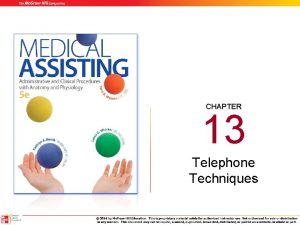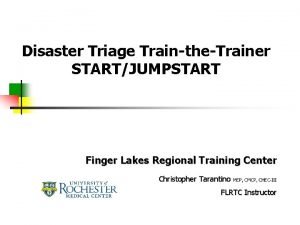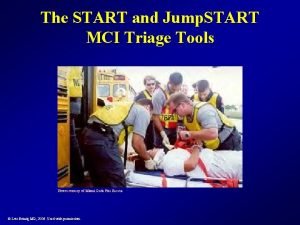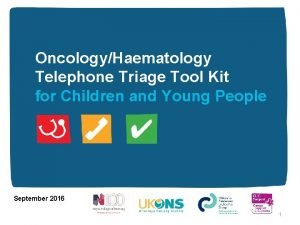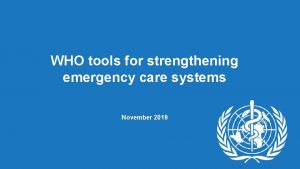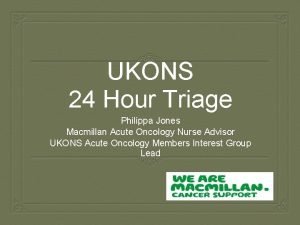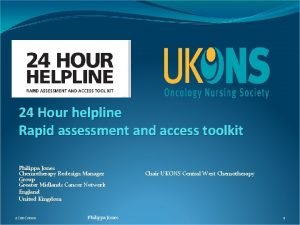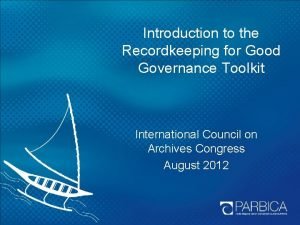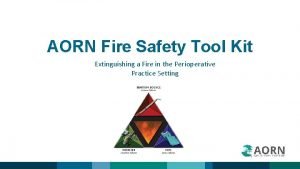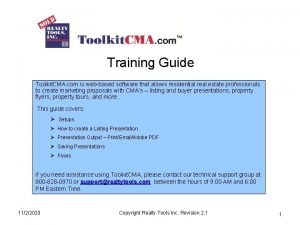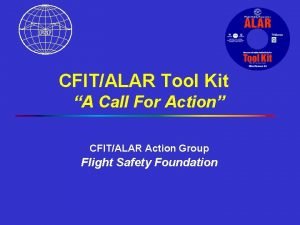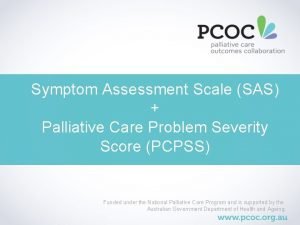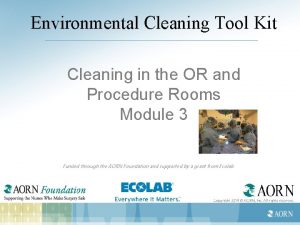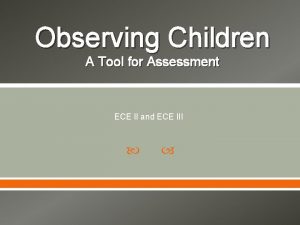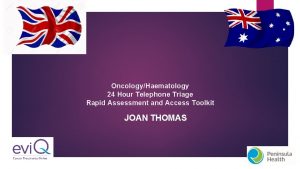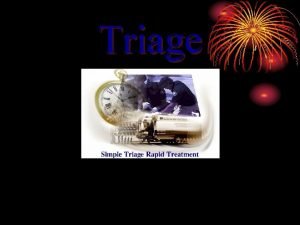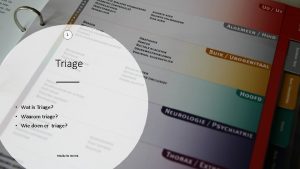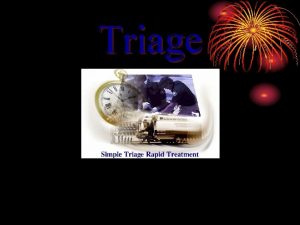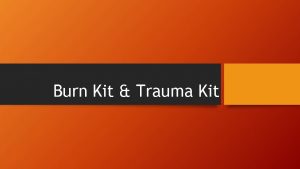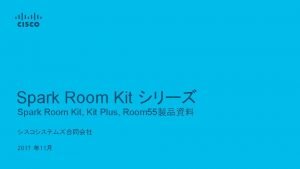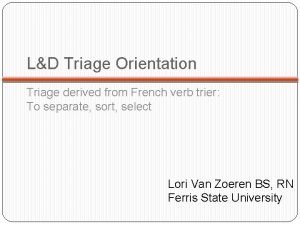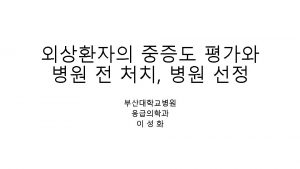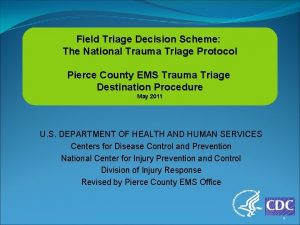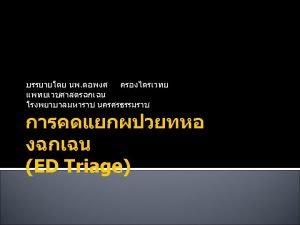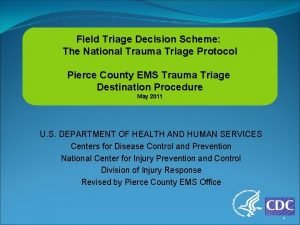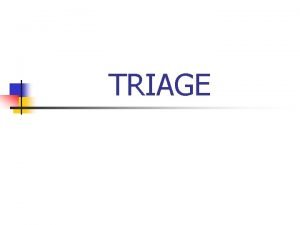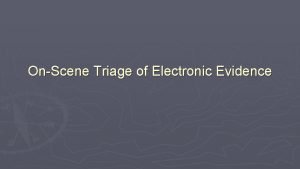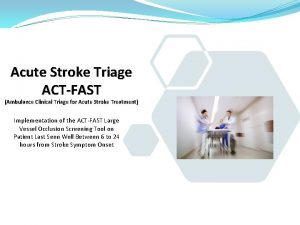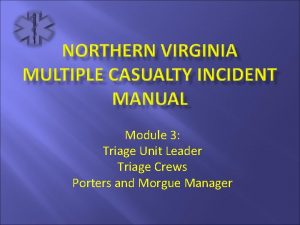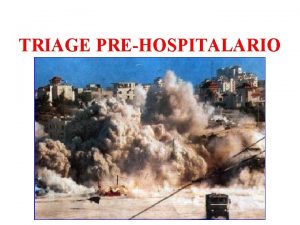OncologyHaematology Telephone Triage Tool Kit for Children and





















































- Slides: 53

Oncology/Haematology Telephone Triage Tool Kit for Children and Young People September 2016 1

This presentation will cover…. • What is the Telephone Triage Tool Kit? • Background • Development history • Evaluation • Implementation • How to use the Tool Kit 2

What is The Telephone Triage Tool Kit? A risk assessment tool using a RAG (RED, AMBER, GREEN) scoring system. For telephone triage of children and young people with cancer and serious blood disorders. 3

Aim of the Tool Kit To provide guidance and support to the practitioner at all three stages of the triage process: • Contact and data collection • Assessment/definition of problem • Appropriate intervention/action. The Tool Kit has been developed to provide: • A simple, reliable assessment process • Safe, understandable advice • Communication and record keeping • Competency based training • An audit tool. 4

Background • United Kingdom Oncology Nursing Society (UKONS) • Adult version developed in 2007/2009 Positively evaluated and released in 2010 • Now used widely in all areas of the UK and internationally • No serious incidents or adverse events due to the use of tool kit reported during the pilot or since release • Updated Version released in August 2016 5

Development of a Telephone Triage Tool Kit for Children and Young People • Meeting with key stakeholders to discuss collaborative working to develop and pilot adapted version of the adult tool for CYP setting • RCN provided funding and advice to support the pilot of the Tool Kit • Pilot – replicated the pilot and evaluation process used in the development of the adult version of the Tool Kit • Training – all staff using the Tool Kit received training and assessment of competency • Two-step evaluation process; Log sheet review (274) and user questionnaire (24) • The pilot ran for a two-month period or completion of 100 log sheets. All sites completed their log sheets during 2013 • Final version of the Toolkit developed with the support and design assistance of CLIC Sargent following positive pilot and evaluation 6

Results of the pilot and evaluation The evaluation of the pilot demonstrated that the Tool Kit achieved its primary aims and objectives. It was shown to be reliable, robust and valuable. The evaluation recommended it should be used as a planned standardised approach to triage and assessment, providing: • An evidence-based assessment tool • A log sheet that acts as a checklist to prompt practitioners and a record of triage and assessment, supporting communication. The evaluation showed that the toolkit sets a standard for best practice and is an excellent training and educational resource: • It can be used to provide evidence of quality and safety for both the organisation and the individual practitioner • It is useful in identifying risks and poor practice, helping to determine education and training needs • It can support consistency of advice, and consistency of service across POSCUs and PTCs as well as between centres. It was positively evaluated by those using it during the pilot. 7

National implementation • The Tool Kit has been endorsed by the United Kingdom Oncology Nursing Society (UKONS), the Children’s Cancer and Leukaemia Group (CCLG), the Royal College of Nursing (RCN) and CLIC Sargent • Principal Treatment Centres and Shared Care Units are recommended to plan local implementation. 8

Factors to consider when planning local implementation • Organisational approval and agreement should be sought as the governance responsibility sits with the user/organisation • Clear decisions should be made about the triage pathway, identifying admission/assessment areas and triage practitioners who will provide review and follow-up calls • A plan for education, training and competency assessment using the Tool Kit. This is a vital step in the process; users need to have a clear understanding of the value of the Tool Kit and the risk to the patient and themselves if it is not used properly • Regular audit and quality review of all data collected – consider electronic data collection • Governance process – as with any service, the advice line will need to be monitored and reported. 9

Training All staff using the Tool Kit must receive training and assessment of competency. • Training should include: • Formal education session • Discussion • Scenario and role play • Observation • A competency framework is supplied to be completed prior to using the Tool Kit • Example scenarios have been provided to assist with training. Staff who are not trained to use the Tool Kit should not provide telephone advice. 10

How to use the Tool Kit 11

The Tool Kit Manual contains • Brief background and development history • Instructions for use • Training and competency requirements and assessment proforma • The Triage Pathway Algorithm and Clinical Governance recommendations • Examples of all component parts of the Tool Kit. 12

Main elements Assessment Tool 13

Main elements Log Sheet 14

Scoring system • Action selection is based on the triage practitioner’s grading of the presenting symptoms/toxicity following interview, data collection and triage: • RED – any toxicity graded here takes priority and action should follow immediately. Patient should be advised to attend for urgent assessment as soon as possible • 2 or more AMBER = RED – if a patient has two or more toxicities graded amber they should be escalated to red action and advised to attend for urgent assessment • AMBER – one toxicity in the amber area should be followed up within 24 hours and the caller should be instructed to call back if they continue to have concerns, or their condition deteriorates • GREEN – callers should be instructed to call back if they continue to have concerns or their condition deteriorates. 15

16

The assessment process step by step 17

The assessment tool will • Determine “the patient’s level of risk“ • Prompt the practitioner with appropriate questions to ask, to gain information from the patient • Provide a reliable guide to toxicity/problem grading • Prioritise the level of urgency indicated by the presenting symptoms and will aid in identifying potential emergency situations. 18

Assessment tool • RED – any toxicities graded here take priority and assessment should follow immediately • 2 AMBER – two or more amber toxicities should be escalated to red action and assessment should follow immediately • 1 AMBER – one toxicity in amber should be reviewed/ followed up within 24 hours and the caller should be instructed to call back if they continue to have concerns, or their condition deteriorates • All GREEN – callers should be instructed to call back if they continue to have concerns or their condition deteriorates. 19

Contact record – the ‘Log Sheet’ It is vitally important that the data collection process is methodical and thorough in order for it to be useful and provide an accurate record of the triage assessment. A Log Sheet should be completed for all calls and unscheduled patient visits. This will facilitate audit of the helpline service. The Triage boxes MUST all be marked accordingly. IF YOU HAVEN’T TICKED IT, YOU HAVEN’T ASKED IT! 20

The Assessment Process Step By Step 1. Perform a rapid initial assessment of the situation: “Is this an emergency? ” Do you need to contact the emergency services. Do you have any doubt about the patient / carer’s ability to provide information accurately or understand questions or instructions provided? If so then a face-to-face consultation must be arranged. Record Name and current contact details in case the call is interrupted and you need to get back to the caller. Step 2. What is the patient/carers initial concern, why are they calling? You should assess and grade this problem first, ensuring that you record this on the log sheet. If this score is RED then you may decide to stop at this point and proceed to organising urgent face-to-face assessment. If the patient is stable you may decide to complete the assessment process in order to gather further information for the face-to-face assessment. Step 3. If the patient / carer’s initial concern scores amber, record this on the log sheet and proceed with further assessment. Move methodically down the triage assessment tool, asking appropriate questions. e. g. Do you have any nausea? If NO tick the green box on the log sheet and move on. If YES use the questions provided to help you grade the problem and note either amber or red and initiate action (tick the log sheet). If the patients symptoms score red or another amber at any time they should be asked to attend for assessment. Step 4. Look back at your log sheet: Have you arranged assessment for patients who have scored RED? Have you arranged assessment for patients who have scored more than one AMBER? Have you fully assessed all the patients who have scored one AMBER, is there a tick in all the other green boxes of the log sheet? Have you fully assessed all the patients who have scored one GREEN, is there a tick in all the other green boxes of the log sheet? Have you recorded the action taken and advice given? Have you documented any decision you have taken or advice you have given that falls outside this guideline, and recorded the rationale for your actions ? Have you fully completed the triage process?

Step By Step 1 • Perform a rapid initial assessment of the situation: “Is this an emergency? ” Do you need to contact the emergency services . . . . 999 • Ask questions in a logical sequence. Follow the log sheet and the assessment tool • Provide information slowly and thoughtfully assess the patient’s comprehension, anxiety and distress throughout the process • Do you have any doubt about the patient/carer’s ability to provide information accurately or understand questions or instructions provided? If so then a face-to-face consultation must be arranged • Record caller’s name and current contact details in case the call is interrupted and you need to get back to the caller. 22

Step By Step 2 • What is the patient/carer’s initial concern, why are they calling? • You should assess and grade this problem first, ensuring that you record this on the Log Sheet. If this score is RED then you may decide to stop at this point and proceed to organising urgent face-to-face assessment • If the patient is stable you may decide to complete the assessment process in order to gather further information for the face-to-face assessment. 23

Step By Step 3 • If the patient/carer’s initial concern scores AMBER, record this on the Log Sheet and proceed with further assessment • Move methodically down the triage assessment tool, asking appropriate questions. e. g. Do you have any nausea? If NO tick the green box on the Log Sheet and move on • If YES use the questions provided to help you grade the problem and note either amber or red and initiate action (tick the Log Sheet) • If the patients symptoms score RED or another AMBER at any time they should be asked to attend for assessment 24

Step By Step 4 Look back at your Log Sheet • Have you arranged assessment for patients who have scored RED? • Have you arranged assessment for patients who have scored more than one AMBER? • Have you fully assessed all the patients who have scored one AMBER, is there a tick in all the other green boxes of the Log Sheet? • Have you fully assessed all the patients who have scored GREEN, is there a tick in all the other green boxes of the Log Sheet? • Have you recorded the action taken and advice given? • Have you documented any decision you have taken or advice you have given that falls outside this guideline, and recorded the rationale for your actions? • Have you fully completed the triage process? 25

Special considerations • If, in the triage practitioner’s clinical judgement, the guideline is not appropriate to that individual situation, the rationale for that decision should be clearly documented • If the triage practitioner’s assessment is borderline select the higher risk category; be cautious • The organisation must agree the triage pathway and populate it with local detail and responsibilities. 26

Log Sheet review The Hospital Designated Responsible Practitioner must review all Log Sheets within 24 hours of the call as follows: GREEN Was this the correct advice? If not is any action / training needed now? 1 AMBER Call the patient to assess if they are improving or not? 2 AMBER or RED Follow the patient: were they admitted or not? Admitted or Discharged Admitted - find them and check management. Discharged - call to see if they are improving. Original log sheet “Review of actions taken” should be completed and filed in the patients medical records 27

Scenarios 28

Scenarios The following scenarios may be used to: • Support role play activity during training • Support general discussion about the value and relevance of the triage process • Demonstrate practical application of the triage process in the clinical setting. 29

Scenario 1 Mum rings to say patients bottle of 6 MP has leaked/smashed on the floor and the dog has eaten some of the medicine. • Patients Name: Humpty Dumpty • Age: 6 yrs • Diagnosis: ALL • Male/Female: Male • Consultant: Dr Betty • Date/time: 12/8/13 14. 00 • Who is calling: Mum • Contact Number: 0191 111111 • Is the patient receiving chemotherapy or radiotherapy: Chemotherapy • State regimen: Maintenance • When did the CYP last have any treatment: On oral chemotherapy • What is the CYP temperature: 36. 5 o. C • Last blood count: Not known • Does the CYP have a CVL: Yes 30

Scenario 1 – Assessment Toxicity/Problem Details Fever Afebrile 36. 5 o. C Infection No signs of infections Activity No concerns Pain No reports of pain Bleeding and Bruising No bleeding or bruising Dyspnoea / Shortness of breath Normal breathing Rash No rash Nausea, Eating and Drinking Fine Vomiting No Mucositis No Diarrhoea No Constipation No Neurosensory / Motor Normal Extravasation No Infectious disease contact No contact Other Yes 31

Scenario 1 – Action taken Please complete a Log Sheet with your assessment and proposed actions. We will check the against Training Log Sheets shortly. 32

Scenario 2 Mum telephoned the Day Unit to say Lou has vomited four times, since waking this morning, she is not herself, not playing but is watching TV. • Patients Name: Looby Loo • Age: 3 yrs • Diagnosis: Brain tumour with VP Shunt • Male/Female: Female • Consultant: Dr Betty • Date/time: 12/8/13 14. 00 • Who is calling: Mum • Contact Number: 0191 1111111 • Is the patient receiving chemotherapy or radiotherapy: Chemotherapy • State regimen: B 12 • When did the CYP last have any treatment: 15 days ago • What is the CYP temperature: 36. 5 o. C • Last blood count: Hb 9. 5, Plts 150, WCC 1. 5, Neut 1. 0 • Does the CYP have a CVL: No 33

Scenario 2 – Assessment Toxicity/Problem Details Fever Afebrile 36. 5 o. C Infection No signs of infections Activity Symptomatic, not playing Pain No reports of pain Bleeding and Bruising No bleeding or bruising Dyspnoea / Shortness of breath Normal breathing Rash No rash Nausea, Eating and Drinking Loss of appetite but eating and drinking Vomiting Four times Mucositis No Diarrhoea No Constipation No Neurosensory / Motor Normal Extravasation N/A Infectious disease contact No contact Other None 34

Scenario 2 – Action taken Please complete a Log Sheet with your assessment and proposed actions. We will check the against Training Log Sheets shortly. 35

Scenario 3 A four-year-old on treatment for ALL, parent concerned about a blotchy rash, otherwise well. • Patient Name: Jessie Jaybird • Diagnosis: ALL • Sex: Female • Consultant: Professor Plum • Date/ time: 20/08/13 14: 00 • Who is calling: mum, Mrs Jaybird • Contact Number: 01910 2829836 • Is the patient receiving chemotherapy or radiotherapy: Chemotherapy • State regimen: UKALL 11 • What did the patient last receive treatment: 13/08/13 • What is the patients temperature: 36. 9 o. C • Last blood count: Haemoglobin 9. 9, Platelets 135 • Does the patient have a central line: Portacath 36

Scenario 3 – Assessment Toxicity/Problem Details Fever Apyrexial 36. 9 o. C Infection No obvious sign of infection Activity Usual active self Pain No pain Bleeding and Bruising No Dyspnoea / Shortness of breath No Rash on trunk – nowhere else Nausea, Eating and Drinking No Vomiting No Mucositis No Diarrhoea No Constipation No – bowels opened this morning Neurosensory / Motor No Extravasation No Infectious disease contact No Other None 37

Scenario 3 – Action taken Please complete a Log Sheet with your assessment and proposed actions. We will check the against Training Log Sheets shortly. 38

Scenario 4 Dad telephone to say his child who was discharged from BMT 3 days ago now had viral symptoms – cough, snotty and temperature 37. 1 o. C. • Patient Name: Joe Blogs • Diagnosis: Post BMT for AML • Sex: Male • Consultant: Dr. Who • Date/ time: 13/08/13 14. 00 hrs • Who is calling: Dad • Contact Number: 12345 109876 • Is the patient receiving Chemotherapy or Radiotherapy: No • State regimen: N/A • What did the patient last receive treatment: 6 weeks post chemo. Day +41 • What is the patients temperature: 37. 1 o. C • Last blood count: Neutrophils 2. 12 • Does the patient have a central line: Yes, TLH 39

Scenario 4 – Assessment Toxicity/Problem Details Fever Apyrexial 37. 1 o. C Infection No signs of infection - no chills, shivering or shaking episodes Activity Mild symptoms – (No real change as post BMT, so had low levels of activity for sometime) Pain No evidence of pain Bleeding and Bruising No evidence of bleeding or bruising Dyspnoea / Shortness of breath No change in breathing pattern, no shortness of breath or chest pain Rash Yes. Generalised raised rash to trunk, hands and feet. Papula with pruritis. Nausea, Eating and Drinking No nausea, eating small amounts (as usual) and meeting fluid target. Vomiting None Mucositis N/A Diarrhoea No diarrhoea Constipation No change from normal bowel habits Neurosensory / Motor No change in mobility / function Extravasation No chemo given for 6 weeks Infectious disease contact No know contacts, on acyclovir Other None 40

Scenario 4 – Action taken Please complete a Log Sheet with your assessment and proposed actions. We will check the against Training Log Sheets shortly. 41

Scenario 5 Attending home visit to do pre-chemo bloods and line flush. After; child feels unwell and has developed a low grade fever. He says similar happened after line flush last week but he didn’t tell anyone and felt better again (doesn’t like going to hospital. ) Line was difficult to bleed and stiff to flush. • Patient Name: Spencer Wells • Diagnosis: Ewing’s Sarcoma • Sex: Male • Consultant: Dr Phalange • Date/ time: 13/08/16 11: 00 • Who is calling: Home Visit Scenario • Contact Number: 0191 111111 • Is the patient receiving Chemotherapy or Radiotherapy: Radiotherapy • State regimen: Euro Ewing 2012 • What did the patient last receive treatment: VAC 10 days ago • What is the patients temperature: 37. 5 o. C • Last blood count: unknown • Does the patient have a central line? : Yes 42

Scenario 5 – Assessment Toxicity/Problem Details Fever 37. 5 o. C after line flush. Reports same last week. Infection CVL Exit site – large dry scab. Not red. Felt unwell after line flush Activity Limited mobility due to surgery but no change recently Pain None Bleeding and Bruising No Dyspnoea / Shortness of breath No Rash No Nausea, Eating and Drinking No change to normal. Drinking well. Vomiting No vomiting, feels a bit nauseous after line flush Mucositis No Diarrhoea No Constipation No Neurosensory / Motor No change from normal. Alert and responsive Extravasation No Infectious disease contact None Other Triple lumen CVL stiff to flush and difficult to bleed 43

Scenario 5 – Action taken Please complete a Log Sheet with your assessment and proposed actions. We will check the against Training Log Sheets shortly. 44

Scenario 6 Panicky call from Mum. Went into Peter’s room this morning. He is not rousable. He is breathing but he is very pale and cold. • Patient Name: Peter Smith • Diagnosis: ALL • Sex: M • Consultant: Prof Plum • Date/ time: 13/08/16 07: 00 • Who is calling: Mrs Janelle Smith • Contact Number: 0777 7777 • Is the patient receiving Chemotherapy or Radiotherapy: Chemotherapy • State regimen: Regimen C • What did the patient last receive treatment: 4 days ago • What is the patient’s temperature: Feels cold to touch • Last blood count: Not assessed • Does the patient have a central line? : Yes 45

Scenario 6 – Assessment Toxicity/Problem Details Fever Feels cold to touch Infection Activity Pain Bleeding and Bruising Dyspnoea / Shortness of breath Rash Nausea, Eating and Drinking Vomiting Mucositis Diarrhoea Constipation Neurosensory / Motor Unrousable Extravasation Infectious disease contact Other 46

Scenario 6 – Action taken Please complete a Log Sheet with your assessment and proposed actions. We will check the against Training Log Sheets shortly. 47

Scenario 7 Mum brought Daisy up to clinic after school with visible hole in blue lumen CVL. Daisy says she got her line caught in her coat zip this morning play time. • Patient Name: Daisy Bell • Diagnosis: ALL • Sex: Female • Consultant: Dr Who • Date/ time: 13/08/16 15: 45 • Who is calling: Drop-in clinic visit. Accompanied by Mum Mrs Avril Bell • Contact Number: 0191 111111 • Is the patient receiving Chemotherapy or Radiotherapy: None • State regimen: UKALL 2013 Regimen A • What did the patient last receive treatment: Completed treatment and awaiting routine line removal • What is the patient’s temperature: 36. 4 o. C • Last blood count: unknown • Does the patient have a central line? : Yes – Double Lumen Hickman 48

Scenario 7 – Assessment Toxicity/Problem Details Fever No, 36. 4 o. C Infection Risk of infection. Damaged CVL – hole in blue lumen since this morning and been at school all day. Activity Normal. Active. Attending school. Pain None Bleeding and Bruising No Dyspnoea / Shortness of breath No Rash No Nausea, Eating and Drinking Normal. Good appetite Vomiting No Mucositis No Diarrhoea No Constipation No Neurosensory/Motor Alert. Lively Extravasation No Infectious disease contact None Other Damaged CVL. 49

Scenario 7 – Action taken Please complete a Log Sheet with your assessment and proposed actions. We will check the against Training Log Sheets shortly. 50

The pilot and evaluation of this tool has shown that the group has developed triage guidelines that can be adopted as a national standard and will: • Improve patient safety and care by ensuring that everyone receives a robust, reliable assessment every time the helpline is contacted for advice • Ensure assessments are of a consistent quality and use an evidence-based assessment tool • Provide management and advice appropriate to the patient’s level of risk. Ensure that those patients who require urgent assessment in an acute area are identified and that appropriate action is taken. Also identify and reassure those patients who are at lower risk and may safely be managed by the primary care team or a planned clinical review and avoid unnecessary attendance • Form the basis of triage training and competency assessment for practitioners • Maintain accurate records of the assessment and decision-making process in order to monitor quality, safety and activity. 51

? Any questions? 52

Thank you! This training pack was developed by the Children and Young People’s Telephone Triage Tool Kit Working Group, with design and support from CLIC Sargent is pleased to support this work for the benefit of children and young people with cancer and their families, and has worked on the design and dissemination of the Tool Kit documents. To find out more about CLIC Sargent visit www. clicsargent. org. uk 53
 Define a routing list as it pertains to incoming calls
Define a routing list as it pertains to incoming calls Jumpstart triage definition
Jumpstart triage definition Oncology triage tool
Oncology triage tool Jumpstart mci
Jumpstart mci Oncology triage tool
Oncology triage tool Emergency care system framework
Emergency care system framework Ukons triage tool
Ukons triage tool Ukons triage tool version 3
Ukons triage tool version 3 Oncology haematology helpline triage tool
Oncology haematology helpline triage tool 4 pillars of sanctuary model
4 pillars of sanctuary model Aorn fire safety tool kit
Aorn fire safety tool kit Corporate governance tool kit
Corporate governance tool kit Aorn fire safety
Aorn fire safety Workforce tool kit
Workforce tool kit Toolkitcma sign in
Toolkitcma sign in Cfit alar
Cfit alar Tool kit learning walk
Tool kit learning walk Pcpss
Pcpss Ecolab housekeeping tool kit
Ecolab housekeeping tool kit Observing children a tool for assessment
Observing children a tool for assessment Potter's wheel data cleaning tool
Potter's wheel data cleaning tool Kontinuitetshantering
Kontinuitetshantering Novell typiska drag
Novell typiska drag Nationell inriktning för artificiell intelligens
Nationell inriktning för artificiell intelligens Returpilarna
Returpilarna Shingelfrisyren
Shingelfrisyren En lathund för arbete med kontinuitetshantering
En lathund för arbete med kontinuitetshantering Kassaregister ideell förening
Kassaregister ideell förening Tidbok för yrkesförare
Tidbok för yrkesförare Sura för anatom
Sura för anatom Förklara densitet för barn
Förklara densitet för barn Datorkunskap för nybörjare
Datorkunskap för nybörjare Tack för att ni lyssnade bild
Tack för att ni lyssnade bild Debatt mall
Debatt mall Delegerande ledarstil
Delegerande ledarstil Nyckelkompetenser för livslångt lärande
Nyckelkompetenser för livslångt lärande Påbyggnader för flakfordon
Påbyggnader för flakfordon Vätsketryck formel
Vätsketryck formel Offentlig förvaltning
Offentlig förvaltning Kyssande vind
Kyssande vind Presentera för publik crossboss
Presentera för publik crossboss Vad är ett minoritetsspråk
Vad är ett minoritetsspråk Kanaans land
Kanaans land Treserva lathund
Treserva lathund Mjälthilus
Mjälthilus Bästa kameran för astrofoto
Bästa kameran för astrofoto Centrum för kunskap och säkerhet
Centrum för kunskap och säkerhet Verifikationsplan
Verifikationsplan Bra mat för unga idrottare
Bra mat för unga idrottare Verktyg för automatisering av utbetalningar
Verktyg för automatisering av utbetalningar Rutin för avvikelsehantering
Rutin för avvikelsehantering Smärtskolan kunskap för livet
Smärtskolan kunskap för livet Ministerstyre för och nackdelar
Ministerstyre för och nackdelar Tack för att ni har lyssnat
Tack för att ni har lyssnat
